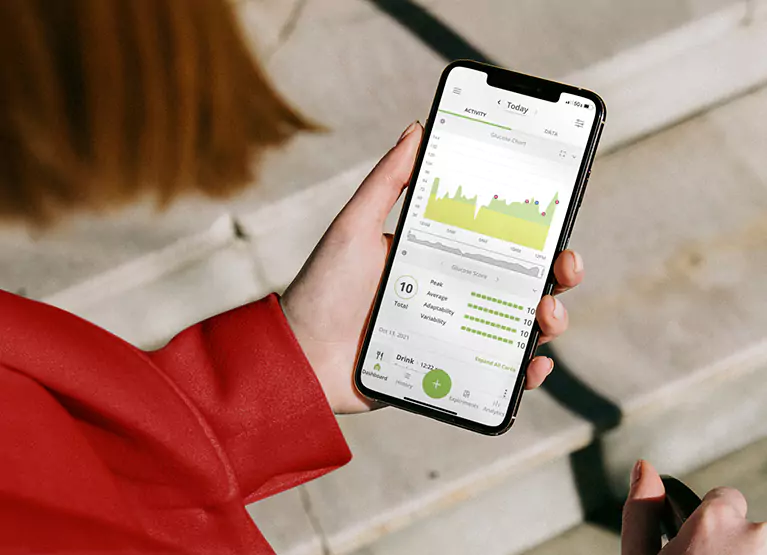The Link Between Gallbladder Removal and High Blood Sugar

Key Takeways
Have you ever wondered what your gallbladder does? This small organ is found next to the liver and is only eight centimeters long.
The gallbladder is actually considered a nonessential organ since you can live normally even after having it removed. However, gallbladder problems and the removal of this organ can have effects on your health, including on your blood sugar.
So, how important really is the gallbladder? And why may some people need to have it removed? Read on to learn more about this organ and how gallbladder problems can impact your health.
What is the Gallbladder?
The gallbladder is a small, pear-shaped organ located right underneath your liver. It stores and concentrates bile, a yellow or brown liquid made in the liver that helps your body digest fat.
Bile is secreted by the gallbladder and travels through the liver through various ducts. It eventually exists through the common hepatic duct and flows through this duct into the gallbladder where it can be stored.
The gallbladder is then stimulated by a hormone called cholecystokinin to push bile through the cystic duct and into the common bile duct. From here, bile enters the small intestine.
However, in some cases, digestive fluid can harden in the gallbladder to cause gallstones. When left untreated, gallstones may lead to infection or inflammation, which is known as cholecystitis.
Gallbladder Problems and High Blood Sugar

The link between high blood sugar and gallbladder problems is still being studied. However, some studies have suggested that the chance of developing gallbladder issues may be higher for people with diabetes.
Though it’s not clear exactly why, this link may have to do with the fact that people with diabetes are more likely to have obesity, liver disease, insulin resistance, and high triglyceride levels. These are all independent risk factors for developing gallbladder problems.
Hyperglycemia, or high blood sugar levels, may also have an effect on the gallbladder’s ability to contract and empty itself of bile, which raises the risk of developing gallstones and other gallbladder diseases.
Gallbladder Removal and Blood Sugar
Research suggests that individuals who have had their gallbladder removed may be more prone to insulin resistance after their surgery. There also may be an increased risk for metabolic changes after gallbladder removal.
These metabolic changes can include a higher risk of developing non-alcoholic fatty liver disease, hyperglycemia, and metabolic disorders like diabetes. The reason for this remains unknown, but research indicates this may have to do with bile acids.
Bile acids play a role in moderating energy, glucose, and cholesterol. The lack of the concentrating function post-cholecystectomy might affect the homeostasis of glucose through a variety of mechanisms.
{{rich-text-cta-cgm1="/style-guide"}}
What is a Cholecystectomy?

If your gallbladder develops problems, like gallbladder disease or gallstones, it may need to be removed. The surgical removal of your gallbladder is called a cholecystectomy.
There are two types of surgeries for this procedure: a laparoscopic cholecystectomy and an open cholecystectomy. Individuals who undergo gallbladder removal will no longer have the ability to store and carefully regulate the secretion of bile. This means that bile may be secreted continuously into the small intestine.
Laparoscopic Cholecystectomy
During a laparoscopic surgery, also known as a keyhole surgery, a surgeon will make small, one centimeter incisions in your stomach to access your gallbladder. A laparoscope, a small telescope with a light and camera, will be inserted into one of the incisions so your surgeon can see inside your stomach.
Surgical instruments will be inserted into another incision and remove your gallbladder. This surgery has a short recovery time of about two weeks, and you can often go home the same day.
Open Cholecystectomy
An open cholecystectomy may be done if you cannot have a keyhole surgery. During an open surgery, a larger 10-20 centimeter incision will be made in your stomach, and your gallbladder will be removed.
Occasionally, a keyhole surgery may be turned into an open surgery if your surgeon cannot properly see your gallbladder or safely remove it. This surgery has a longer recovery time of six to eight weeks.
Who Needs a Cholecystectomy?

There are a number of problems that can affect the gallbladder that may result in surgical removal, including inflammation and gallstones.
Gallstones
The most common problem that affects the gallbladder is the development of gallstones. As we mentioned earlier, gallstones can appear when bile hardens in the gallbladder, creating a stone-like material.
This is thought to be caused by an imbalance in the chemical make-up of the bile, and is most often because the level of cholesterol in the bile is too high. Gallstones do not always cause symptoms, but if they do, gallbladder removal is a common treatment option.
Symptoms of gallstones can include:
- Severe pain in the upper abdomen that may last several hours, and quickly increases in severity
- Pain in the right shoulder or in the back (between your shoulder blades)
- Nausea and vomiting
- Fever
- Chills
- Jaundice (a yellowing of the skin or eyes)
Contact your health care provider if you develop these symptoms. You may be at higher risk of gallstones if you:
- Have excess estrogen from pregnancy, hormone replacement therapy, of birth control pills
- Are overweight or obese
- Are Native American
- Are over the age of 60
- Have diabetes
- Take cholesterol-lowering drugs
Cholecystitis

Cholecystitis is inflammation of the gallbladder that happens when bile is trapped inside and builds up inside the gallbladder. Cholecystitis can be sudden and acute, or a chronic, long-term condition.
Gallstones often cause cholecystitis, but it can also be caused by bacterial infections, tumors in the liver or pancreas, or a reduced blood supply to the gallbladder caused by diabetes.
Symptoms of cholecystitis are similar to those of gallstones and can include:
- Intense and sudden pain in the upper right portion of your belly
- Pain that worsens with deep breaths, and spreads to the back below your right shoulder blade
- Nausea and vomiting
- Fever
- Jaundice
Other Factors that Affect Gallbladder Health

Insulin Resistance
Several studies have shown that insulin resistance can increase your risk of forming gallstones. This may be due to the fact that insulin resistance affects the amount of cholesterol in your bile.
Obesity
Obesity is associated with an increased risk of gallstones, especially in women. Because people with obesity tend to have higher levels of cholesterol in their bile, they may be more likely to develop gallstones.
High Levels of Triglycerides
A high level of triglycerides are associated with formation of gallstones. Triglycerides are a type of fat found in the blood.
Your body creates this fat from calories you eat, and stores them in fat cells to be used for later energy. Eating more calories than your body can use for energy can lead to high triglyceride levels.
Low Fiber Diet

Eating enough fiber is not just important for regulating your blood sugar levels and supporting digestive health. A diet low in fiber may increase your risk of developing gallbladder issues.
This is because fiber can help decrease the accumulation of bile in your gallbladder and lower your cholesterol levels. Including adequate fiber in your diet may help reduce your risk of gallbladder issues.
Liver Disease
People with liver disease, especially cirrhosis, have a higher risk of developing gallstones. Researchers believe that this may be because liver disease can change the chemical composition of bile.
What to Eat After Gallbladder Removal

There is no standard diet for people who have had their gallbladder removed. However, there are certain foods that should be limited to avoid symptoms like diarrhea and bloating.
Since bile that would normally be stored in the gallbladder is released directly into the intestines, some individuals may experience gastrointestinal distress after this surgery. Due to the correlation between gallbladder removal and hyperglycemia, you should also consider following a glucose-friendly diet.
Watch your Fat Consumption
After gallbladder surgery, you may want to limit high-fat, fried, and greasy foods. Smaller amounts of fat are easier for your body to digest, and will help you avoid gas, bloating, and diarrhea.
While consuming fat will likely not impact your blood sugar, a high-fat diet can slow down your digestion, which can make it harder for your insulin to work like it should. High fat intake has also been linked to increased risk for gallbladder disease in some people.
Add Plenty of Fiber to your Diet
As we mentioned earlier, fiber is crucial for healthy digestion, and can bulk up your stool. This nutrient also helps slow the absorption of sugar from your food, which can improve your blood sugar response.
Legumes, fruits, vegetables, and whole grains are all great sources of fiber. If you want to increase your fiber intake, it’s important to do so slowly over several weeks, as eating too much fiber very quickly may increase gas and bloating.
Eat Smaller Meals More Frequently

Eating smaller meals more frequently can help your food mix better with the bile in your digestive system. Smaller, frequent meals may also be beneficial for blood sugar regulation.
A 2018 study found that people who eat three small meals a day have better glycemic control than people who eat three meals per day. Opt for balanced meals that include lean proteins, whole grains, and fruits and vegetables.
Find the right Nutrisense programto turn insight into progress.
Go Beyond Glucose Data with Nutrisense
Your glucose can significantly impact how your body feels and functions. That’s why stable levels are an important factor in supporting overall wellbeing. But viewing glucose isn't enough. Nutrisense, you’ll be able to learn how to use your body's data to make informed lifestyle choices that support healthy living.
One-to-one coaching
Sign up to access insurance-covered video calls to work with a glucose expert: a personal registered dietitian or certified nutritionist who will help tailor your lifestyle and diet to your goals.
Monitor and measure what matters
With the Nutrisense CGM Program, you can monitor your glucose with health tech like glucose biosensors and continuous glucose monitor (CGM)s, and analyze the trends over time with the Nutrisense App. This will help you make the most informed choices about the foods you consume and their impact on your health.
Find your best fit
Ready to take the first step? Start with our quiz to find the right Nutrisense program to help you take control.

Heather is a Registered and Licensed Dietitian Nutritionist (RDN, LDN), subject matter expert, and technical writer, with a master's degree in nutrition science from Bastyr University. She has a specialty in neuroendocrinology and has been working in the field of nutrition—including nutrition research, education, medical writing, and clinical integrative and functional nutrition—for over 15 years.


.webp)

